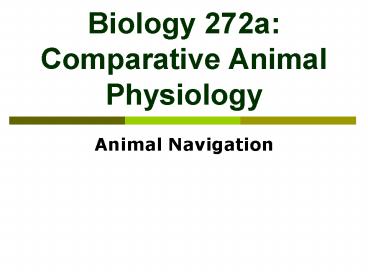Biology 272a: Comparative Animal Physiology - PowerPoint PPT Presentation
Title:
Biology 272a: Comparative Animal Physiology
Description:
Biology 272a: Comparative Animal Physiology Animal Navigation * * * * * Demonstrates that adults have an acquired map sense that they use to modify their migration ... – PowerPoint PPT presentation
Number of Views:15
Avg rating:3.0/5.0
Title: Biology 272a: Comparative Animal Physiology
1
Biology 272a Comparative Animal Physiology
- Animal Navigation
2
Why do animals navigate?
- Reproduction
- Food and other resources
- Avoiding inclement conditions
- Finding home
- An ultimate question
3
How do animals navigate?
- A proximate question
4
Navigational Strategies
- Trail following/route learning
- Piloting
- Path integration
- Compass navigation
- Map-and compass navigation
5
Trail following/route learning
- Trails may be visual (e.g. deer trails)
- Olfactory (e.g. pheromone trails in ants)
6
Piloting
- Using landmark cues to find a known location
7
Niko Tinbergen (1907-1988)
- Nobel prize for Physiology or Medicine (1973)
- PhD Thesis (32 pages long!) on navigation in
digger wasps (Beewolves)
8
Philanthus - Beewolves
Hymenoptera Crabronidae
9
Piloting
- Homing pigeons (once in home area)
- Clarks Nutcrackers (food caching)
10
Path integration
- Dead Reckoning
- Know direction Distance and calculate position
from there - Long way out, short way home
11
Path integration in desert ants (Cataglyphis
fortis)
12
How do ants know how far theyve gone?
13
How do they know which direction theyve gone?
- Compass based on visual cues
- Celestial
- Sun position
- Polarised light
14
Star compasses
15
Star compasses
- Nocturnal migrating/flying birds
- Seabirds
- (some) migrating song birds
- Experiments
- Raise birds so they can see night sky, but not
landmarks - Raise birds in planetariums with weird star
configurations
16
Sun Compasses
- Need to know time of day
- If manipulate this, animal moves in wrong
direction
17
Sun Compasses
Fig 17.5
18
Polarised light
The direction from which this polarised light
comes indicates the direction of the sun
Fig. 17.6a
19
Polarised light
Fig. 17.6b
Polarised light means you can tell where the sun
is even on a cloudy day!
20
How do insects see polarised light?
Ommatidium
Dorsal rim of Compound eye has particular focus
on polarised light
Aligned Rhodopsin molecules
21
Magnetic fields theyre out there!
Fig 17.8
22
Magnetic fields organisms can detect them!
- Magnetic bacteria use magnetosomes to orient to
magnetic fields
23
Animals can detect magnetic fields
24
Migrating fin whales avoid areas of strong
magnetic fields
25
How do we show that animals can actually detect
magnetic fields, and how do they do it?
26
How do animals detect magnetism? I Trout
- Magnetite crystals associated with specialised
cells in nose of trout - If blocked, magnetic sense disappears
27
How do animals detect magnetism? II - Birds
- Evidence that the nose is required for
magnetoreception in pigeons - cf. magnetite in trout nose
- Previous studies that blocked nose may have been
blocking magnetoreception, not smell - Most evidence suggests that magnetoreception
map rather than compass in birds
28
How do animals detect magnetism? III Birds (again)
- Resonant molecules?
- Some evidence from birds that light-affected
molecules (e.g. rhodopsin) might return to
unexcited state at different rates under
different magnetic conditions - Some magnetoreception is light-dependent
29
How do animals detect magnetism? IIIa Flies
- A blue-light receptor is necessary for
magnetoreception - Gene identified, knockout flies dont respond to
magnetic fields
30
How do animals detect magnetism? IV Sharks
- Are known to swim in straight lines across long
distances of open ocean - Can detect electricity
- Ampullae of Lorenzini
- Is electromagnetic induction as they swim
generating currents they can detect?
31
Magnetic sense can provide animals with both a
map and a compass
- Magnetic anomalies
32
Map and compass
- Many animals have a visual (or olfactory) map of
their surroundings, which they combine with a
compass to allow them to navigate.
33
Fig 17.10
34
Navigational Strategies
- Trail following/route learning
- Piloting
- Path integration
- Compass navigation
- Map-and compass navigation
35
Reading for Tuesday
- Biological clocks
- Pp 383-389































